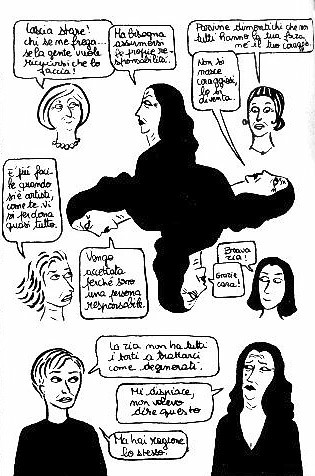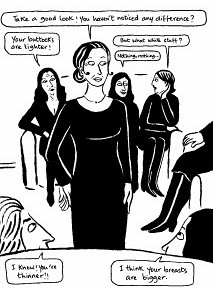'Embroideries' by Marjane Satrapi (2005)
Marjane Satrapi’s Embroideries culls similar source material as her autobiographical graphic narrative Persepolis, which depicts the conservative political climate in Iran after the revolution of the late 1970s. While Persepolis is personal in the sense that it is Satrapi’s story of growing up in pre- and post-revolution Iran, it has a larger scope as it also describes the effects of the revolution on Iran at a national scale. Embroideries is a more personal novel, occurring during the span of an afternoon and depicting the conversation of nine women having tea.
In Persepolis, Satrapi used a traditional panel form in telling her story, but in Embroideries she abandoned the panels.

In an interview with Fire on the Prairie, Satrapi comments that she did not use panels to facilitate and mimic the fluidity of conversation. Indeed, the lack of panels allows Satrapi to move from past to present – from the conversation to a memory – and allow her characters to interrupt each other, returning abruptly to the present again. But without boxes, this conversation seems less defined by time or by space. Satrapi’s drawing style is very minimalist: she draws her characters and whatever furniture they are sitting on or objects they might be touching but rarely provides details of the background. There are definite indications of Iranian culture in this novel, but often they come as a surprise. When Satrapi recounts a story in which two women are seen outside in the street, it was jarring for me as the reader to see them suddenly wearing hijab – I was very abruptly reminded of the cultural context of the story. Persepolis can only occur in a specific time and place, but Embroideries is a more universal story.
However, the very candid conversations about sex in which the women engage are not found in every culture. Most people view Iranian women as sexually repressed and oppressed, therefore the explicitness of the stories these women tell might be shocking to some readers. Indeed, I think that Satrapi intends to stretch people’s comprehension of the sex lives of Iranian women. One of the women, a mother of five, has never seen a penis and the women discuss hymen restoration surgery – the title is actually a reference to a slang term for such surgeries – but most of the women speak freely of enjoying sex.

Satrapi’s drawing style fascinates me because the white space seems to define the black areas instead of the opposite.
Embroideries strikes me as a story or example of survival. The title, like the women in this novel, is subversive. The idea of “embroideries” calls to mind afternoons of women sewing together, rather than the more disturbing connotation of hymen reconstruction to prevent women from being harmed for not being virgins when they marry. I do not think that Satrapi intends to criticize these women who have embroideries – as her grandmother says, “If people want to be sewn up, let them be sewn up” – but rather she is presenting the situation in Iran as it is. As disturbing as hymen reconstruction might seem to a woman like myself, Iranian women might see it as a logical solution for wanting to have premarital sex without taking the risk of not being a “virgin” on their wedding night. They are adapting to their cultural climate, seemingly conforming to the establishment while actually subverting it.
 This blog contains what I think about movies, TV, short stories and crap like that. This blog is chock-full o' spoilers, so be warned. Though I don't tend to write about anything current, so I doubt there's much here to spoil anybody.
This blog contains what I think about movies, TV, short stories and crap like that. This blog is chock-full o' spoilers, so be warned. Though I don't tend to write about anything current, so I doubt there's much here to spoil anybody.